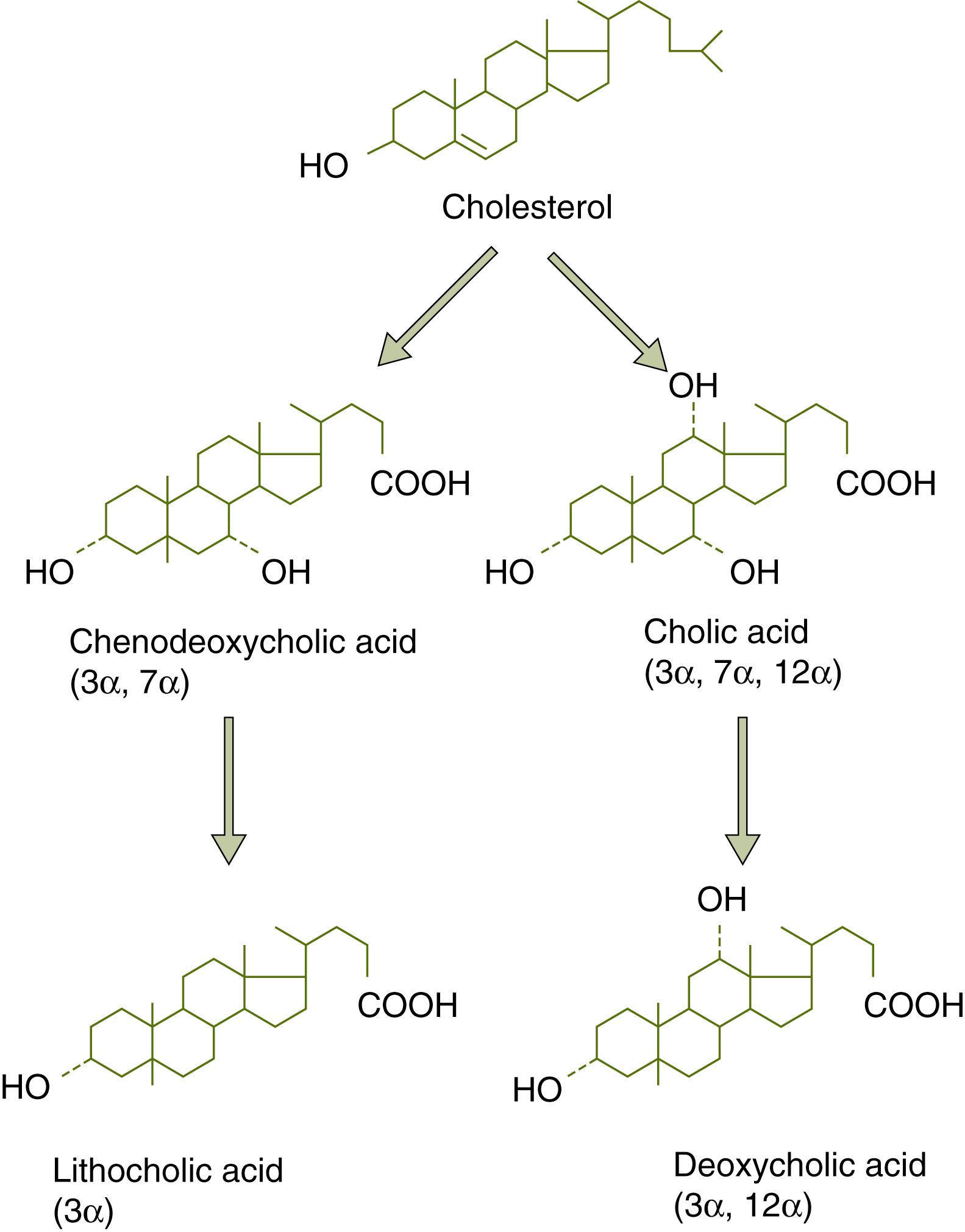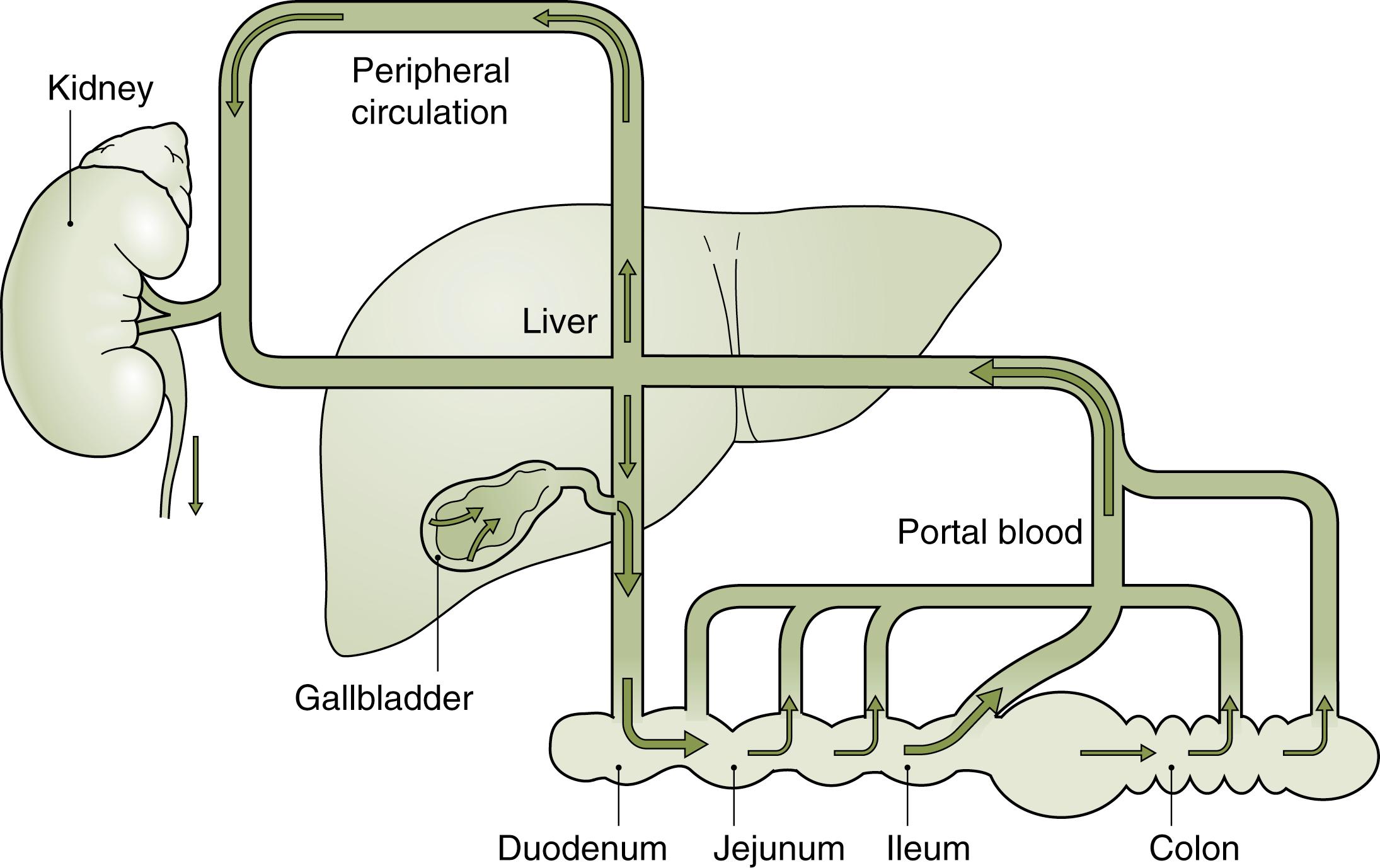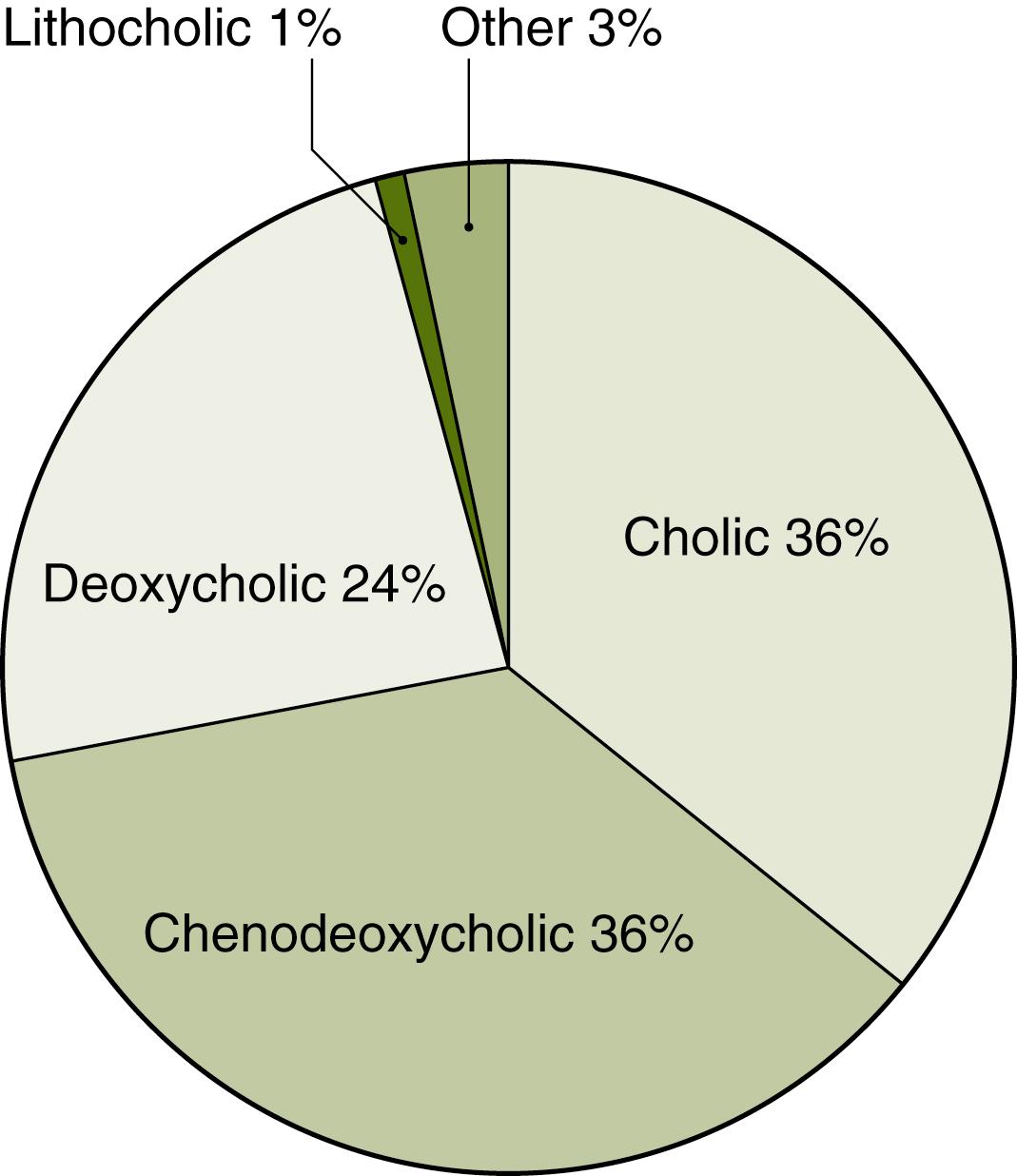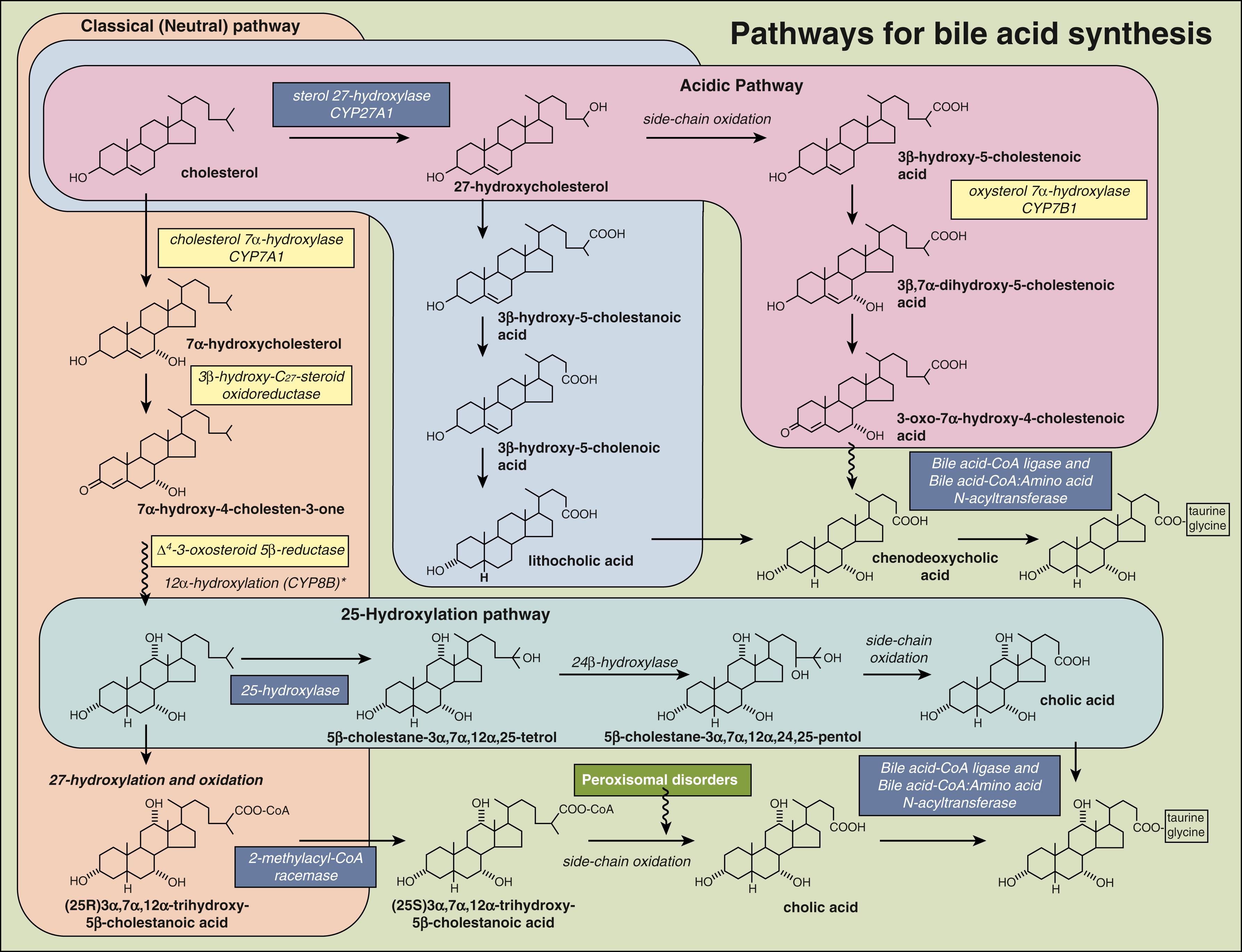Physical Address
304 North Cardinal St.
Dorchester Center, MA 02124
Bile acids are essential in the processing of dietary lipids and serve at least four major functions: (1) Bile acids aggregate and form micelles in the upper small intestine, which help to solubilize lipolytic products, cholesterol, and fat-soluble vitamins, thereby facilitating absorption across the intestinal epithelium. (2) Bile acids stimulate bile flow during their secretion across the biliary canaliculus. (3) Bile acids are major regulators of sterol metabolism and serve as a major excretory pathway for cholesterol from the body. (4) Bile acids play key roles in multiple important signaling pathways.
Bile acids undergo an enterohepatic circulation within the liver, biliary tract, intestinal tract, and the portal and peripheral circulations. This carefully regulated enterohepatic circulation allows for conservation of bile acids. Any alteration in this circulatory pathway can lead to either a loss of bile acids from the body or displacement from the gastrointestinal tract with associated clinical manifestations. This chapter will review the normal bile acid physiology and discuss the clinical manifestations of defects of bile acid biosynthesis and clinical conditions associated with alterations in bile acid transport in the liver and gastrointestinal tract.
The two primary bile acids, cholic acid (CA) (3α,7α,12α-trihydroxy-5β-cholanoic acid) and chenodeoxycholic acid (CDCA) (3α,7α-dihydroxy-5β-cholanoic acid), are synthesized in the liver from cholesterol ( Fig. 3.1 ). The synthesis of these acids occurs through a tightly regulated enzymatic cascade within hepatocytes involving at least 15 different enzymes. Modifications to the cholesterol nucleus occur via two different biosynthetic pathways: the classic, or neutral, pathway and the alternative, or acidic, pathway. Both pathways work to convert a hydrophobic cholesterol molecule into hydrophilic primary bile acids.

The neutral pathway of bile acid biosynthesis involves the formation of a CA to CDCA ratio of approximately 1:1. The initial step of cholesterol synthesis in the neutral pathway involves the 7α-hydroxylation of cholesterol by the rate-limiting enzyme, cholesterol 7α-hydroxylase. Compared with the neutral pathway, the alternative pathway of bile acid biosynthesis predominately yields CDCA with smaller amounts of CA. Although the neutral pathway is believed to be the quantitatively more important pathway of bile acid synthesis, the alternative pathway is likely more functional early in life, and alterations in this pathway may have devastating consequences. ,
Virtually all primary bile acids are conjugated with either glycine or taurine after synthesis by hepatocytes. This conjugation effectively decreases the permeability of bile acids to cholangiocyte cellular membranes, thereby delivering higher concentrations to the intestines. Conjugation also inhibits digestion of bile acids by pancreatic carboxypeptidases and absorption in the proximal small intestine.
The bile acid pool in humans is typically composed of the primary bile acids, cholic and CDCA, and the secondary bile acids, deoxycholic and lithocholic acid. Ursodeoxycholic acid accounts for only 1% to 3% of the bile acid pool. This pool of bile acids circulates through the liver, biliary tract, intestine, portal circulation, and peripheral serum in response to meal stimuli ( Fig. 3.2 ). Maintenance of a pool of bile acids is essential to normal fat absorption and bile secretion.

For adults and children beyond infancy, newly synthesized bile acids account for approximately 20% to 25% of the total bile acid pool. This percentage can be greatly increased in patients with impaired bile acid reabsorption as found in patients with Crohn disease or necrotizing enterocolitis who had ileal resection. Once synthesized by hepatocytes, bile acids are excreted into the canalicular lumen. In addition to bile acids, a sodium ion is excreted, which creates a gradient to passively draw water into the biliary canalicula. This flow of bile acids and water serves as the major stimulus for bile flow. While bile acids make up the major solute of bile, other components include phospholipids, organic anions, inorganic anions (especially chloride), and cholesterol.
Most of the bile acids secreted from the liver are stored in the gallbladder as mixed micelles accompanied by phospholipid and cholesterol. Upon consumption of a meal, the gallbladder contracts and bile acid micelles are delivered to the small intestine (see Fig. 3.2 ). In the proximal small bowel, bile acids form mixed micelles with dietary lipolytic products, fatty acids, and monoglycerides. Cholesterol, phospholipids, and fat-soluble vitamins are also solubilized in a similar manner. The lipolytic products are absorbed in the proximal small intestine with reabsorption of excess bile acids in the distal intestine. Bile acids may be reabsorbed by either passive nonionic diffusion along the length of the gastrointestinal tract or by a sodium-dependent mechanism in the ileum. Reabsorption is limited in the upper small bowel because the pKa values of bile acids tend to be too low to be absorbed by nonionic diffusion, although there is some absorption of unconjugated and glycine-conjugated bile acids.
Upon initial entry into the small intestines, bile acids have a net negative charge. As the bile acids pass through the more distal small intestine, the colonized bacteria deconjugate the bile acids. This deconjugation confers a neutral charge to the bile acids and thus permits rapid uptake by intestinal endothelial cells via passive diffusion. With each of the 8 to 12 enterohepatic cycles every day, there is loss of only 3% to 5% of the pool of bile acids with each cycle, largely due to an efficient absorption by the combination of passive and active transport systems in the intestine.
A fraction of bile acids in the pool escape reabsorption in the small intestine and are delivered to the large intestine, where further bacterial transformation of the bile acids occurs. After bile acid deconjugation, bacterial 7α-dehydroxylation of CA and CDCA may occur, causing formation of the secondary bile acids deoxycholic acid (3α,12α-dihydroxy-5β cholanoic acid) and lithocholic acid (3α-hydroxy-5β cholanoic acid) (see Fig. 3.1 ).
Small quantities of bile acids are lost in the stool each day. Although the amount varies by diet and individual, in the adult up to 30 g of bile acids are reabsorbed by the intestines, with 0.2 to 0.6 g being eliminated in the stool daily. The bile acids that are lost in the stool are replaced by newly synthesized bile acids in the liver through a tightly controlled negative feedback system. The rate-limiting enzyme for bile acid synthesis in the neutral pathway, cholesterol 7α-hydroxylase, is tightly regulated by farnesoid X receptor (FXR) and FGF-19. FGF-19 is a fibroblast growth factor produced by the ileum in response to bile acid reabsorption that feeds back to the liver to suppress further bile acid production. FXR is a nuclear receptor that uses feedback inhibition to respond to excess bile acids and facilitates cholesterol and bile acid homeostasis via regulation of a variety of metabolic enzymes and transporters. These feedback inhibition mechanisms ensure that the bile acid pool remains constant in healthy humans, thereby securing adequate bile acids to promote bile flow, micelle formation, and cholesterol excretion. Disease processes that alter the bile acid pool profile can affect feedback signaling to FXR. In patients with diabetes, impaired insulin activity results in changes in the bile acid pool composition that can decrease FXR activity and cause systemic complications such as elevated triglycerides. Alternatively, pharmacologic stimulation of FXR can affect bile acid pool composition with systemic consequences. Synthetic FXR agonist therapy has been shown to decrease bile acid pool size and induce obesity and diabetes.
Bile acids enter the portal venous system upon absorption by enterocytes. These bile acids are bound to albumin and other proteins as they are transported in the portal vein to the liver. Up to 90% of these bile acids are removed by the liver during their first pass. Most of the reuptake is performed by periportal hepatocytes that then secrete the bile acids into the canalicular space, the rate-limiting step of bile acid transport. A small fraction of the circulating bile acids in the portal blood escape removal by the hepatocytes and spill over into the systemic circulation. Therefore, with each cycling of bile acids, there is a characteristic small spillover of bile acids in the serum that can be measured. A postprandial rise of bile acids serves as a reasonable indicator that the enterohepatic circulation is intact. Serum bile acids that have escaped hepatic uptake undergo filtration by the kidney and can either be excreted in the urine or reabsorbed in the renal tubules for transport back to the liver.
Although bile acid synthesis has been demonstrated as early as the 12th week of gestation, neonates are born with an underdeveloped enterohepatic circulation of bile acids. An immature synthetic pathway of bile acids exists in the developing fetus that not only leads to a decreased rate of bile acid synthesis but also to the production of “atypical” bile acids not seen in the normal child or adult. These “atypical” bile acids have additional sites of hydroxylation, which may be important in the pathogenesis of cholestatic liver disease in the neonate. Although the primary bile acids, CA and CDCA, make up approximately 75% to 80% of the biliary bile acids in adults, they make up less than 50% of the total bile acid pool of the fetus. At birth, bile acid synthesis triggers the induction of the transporters involved in enterohepatic circulation through activation of FXR. The maturation process continues within the newborn and throughout the first year of life, which effectively increases the amount of bile acids available for digestion and transporters available for trafficking.
Newborns initially have decreased synthesis of bile acids and decreased bile acid pool size. However, both increase during the first several months of life. The decreased bile acid pool size is accompanied by a reduced concentration of intraluminal bile salts. Both term and preterm normal newborn infants have reduced rates of CA synthesis and a reduced pool size compared with normal adults when corrected for differences in body surface area. In vitro studies suggest that ileal bile acid transport is decreased in human newborns. In addition to the impaired synthesis and ileal uptake of bile acids in newborns, the pressure generated by contraction of the newborn gallbladder may be insufficient to overcome the choledochal resistance to bile flow. For preterm infants less than 33 weeks’ gestation, the gallbladder contraction index may be nonexistent to less than 50%. Impaired gallbladder contraction may explain why 0.5% of normal neonates have gallstones or gallbladder sludge. A decrease in intraluminal bile salt concentration in the neonate contributes to a phenomenon of decreased fat absorption known as “physiologic steatorrhea.” Over the first months of life, the bile acid synthetic rate increases and the pool expands with concurrent increase in intraluminal bile acid concentrations.
Despite having a decreased rate of bile acid synthesis and decreased bile acid pool size, the serum bile acid concentration is typically increased in normal preterm and term newborn infants. In fact, the serum bile acid concentration during the first 6 months of life is as high as in adults who have clinical cholestasis. The elevated serum bile acids during this period have been termed “physiologic cholestasis.” The early elevation in serum bile acids relates to a poor hepatic extraction of bile salts from the portal circulation. This hepatic uptake is especially impaired in preterm infants. An improvement in the hepatic uptake of bile acids occurs over the first year of life and corresponds to a decrease in the peripheral serum bile acid concentration. Levels of serum bile acids in infants decrease into the normal range by approximately 10 months of age.
The bile acid composition in neonates is predominately the primary bile acids, CA and CDCA. An appearance of the secondary bile acids, lithocholic and deoxycholic acid, occurs in both the serum and bile of infants upon intestinal microflora colonization. As the infant matures, primary and secondary bile acids continue to be synthesized and recirculated. The concentration of bile acids in humans eventually approximates the following: CA (36%), CDCA (36%), deoxycholic acid (24%), and lithocholic acid (1%) ( Fig. 3.3 ).

Disruptions in any part of the enterohepatic circulation of bile acids can lead to the development of clinical manifestations ranging from cholestasis to diarrhea. Alterations may occur at the level of primary bile acid synthesis, in the transport of bile acids across the hepatocyte, at the level of secondary bile acid synthesis, or in ileal transport and the recirculation of bile acids.
Disorders in bile acid synthesis and metabolism can be broadly classified as primary or secondary ( Fig. 3.4 ). Primary enzyme defects involve congenital deficiencies in enzymes responsible for catalyzing key reactions in the synthesis of cholic and CDCAs. The most commonly identified defects include 3β-hydroxy-C 27 -steroid oxidoreductase deficiency; Δ 4 -3-oxosteroid 5β-reductase deficiency; oxysterol 7α-hydroxylase deficiency; 27-hydroxylase deficiency or cerebrotendinous xanthomatosis (CTX); 2-methylacyl-CoA (Coenzyme A) racemase (AMACR) deficiency; trihydroxycholestanoic acid CoA oxidase deficiency; amidation defects involving a deficiency in the bile acid–CoA ligase (BACL) and bile acid–CoA; and amino acid N-acyl transferase; and side-chain oxidation defect in the 25-hydroxylation pathway for bile acid resulting in an overproduction of bile alcohols. Secondary metabolic defects that impact primary bile acid synthesis include peroxisomal disorders, such as Zellweger spectrum disorders (ZSDs) and Smith-Lemli-Opitz syndrome. The biochemical presentation of these bile acid synthetic defects includes a markedly reduced or complete lack of cholic and CDCAs in the serum, bile, and urine with greatly elevated concentrations of atypical bile acids and sterols that retain the characteristic structure of the substrates for the deficient enzyme and may have intrinsic hepatotoxicity. These signature metabolites are generally not detected by the routine methods for bile acid measurement, and mass spectrometric techniques currently provide the most appropriate means of characterizing defects in bile acid synthesis. Screening procedures using liquid secondary ionization mass spectrometry (LSIMS), formerly known as fast atom bombardment–mass spectrometry (FAB-MS), indicate that inborn errors in bile acid synthesis probably account for 1% to 2% of the cases of samples sent for analysis from infants, children, and adolescents.

Successful treatment of bile acid synthetic defects has been achieved in most patients with oral CA therapy approved by the US Food and Drug Administration (FDA) in 2015 under the trade name Cholbam. Oral CA leads to downregulation of bile acid synthesis resulting in a sustained reduction or disappearance of toxic, atypical bile acid metabolites. In addition, oral CA enables adequate levels of primary bile acids to generate bile flow and improved intraluminal concentrations of bile acids. Clinically, response to therapy has been demonstrated with normalization of liver chemistries along with improvement in growth and liver histology. , Oral glycocholic acid is an effective treatment for amidation defects that leads to improved growth and fat-soluble vitamin absorption.
Become a Clinical Tree membership for Full access and enjoy Unlimited articles
If you are a member. Log in here